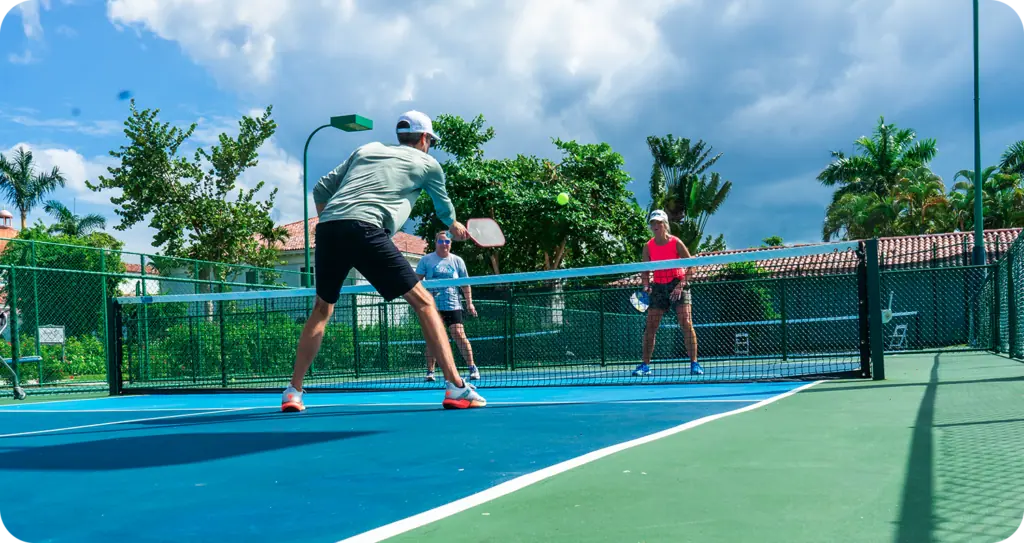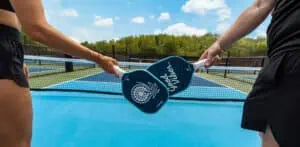Pickleball
Pickleball Rules and Scoring: A Beginner’s Guide Explained
Welcome to the exciting world of pickleball! If you’ve ever found yourself intrigued by this fun and fast-paced sport, you’re not alone. Pickleball has gained popularity all over the globe, appealing to players of all ages and skill levels. Its unique combination of elements from tennis, badminton, and ping-pong creates an engaging experience that keeps people coming back for more. But before you grab a paddle and hit the court, it’s essential to learn the rules and scoring basics that define the game. In this guide, we’ll break down everything a beginner needs to know, from fundamental rules to effective playing strategies, setting you up for a successful start in your pickleball journey. Let’s dive in!
Beginners should understand that pickleball can be played in singles or doubles on a standard court with specific serving rules, such as a diagonal serve and maintaining one foot behind the baseline. In terms of scoring, matches typically go to 11, 15, or 21 points, with points awarded only to the serving team; additionally, players must adhere to the two-bounce rule, where both teams must let the ball bounce once before returning it after a serve.

Basic Pickleball Rules for Beginners
One fundamental rule every beginner should grasp is the significance of the non-volley zone, affectionately referred to as “the kitchen.” This important area stretches 7 feet on either side of the net. Players must be cautious; stepping into the kitchen while attempting to volley results in a fault. This rule actively fosters strategy in the game by discouraging aggressive net play and encouraging players to think ahead about their moves.
Non-Volley Zone (The Kitchen)
In practical terms, imagine you’re positioned near the net, ready to deliver a powerful return against your opponent’s serve. If you step into the kitchen before hitting, your effort counts for nothing, as it’s deemed a fault. Understanding this rule encourages players to respect boundaries and adds an element of tactical planning to shot placement. More importantly, it invites a diverse range of shots that can keep opponents guessing.
Building upon that, another essential guideline involves what’s known as the two-bounce rule.
Two-Bounce Rule
The two-bounce rule states that both sides must allow the ball to bounce once on their respective side before returning it. This additional layer makes every rally slightly more exciting and dynamic. Picture this: you’ve just served, and instead of rushing to smother the ball with an aggressive volley, you must let it bounce first. This encourages longer exchanges and enhances your reaction skills.
For beginners, adhering strictly to this rule not only gives players time to position themselves properly but also instills patience. Rallies stretch a bit longer, allowing novice players a chance to settle into their rhythm despite pressures from better opponents. By allowing time for reactions, beginners can improve their overall gameplay without feeling overwhelmed.
After mastering these initial guidelines, we now focus on how games are structured regarding scoring.
Game Intervals
Typically, a pickleball game is played to 11 points, though it’s crucial to achieve at least a two-point lead over your opponent to win. Some matches—especially in competitive settings—can extend to 15 or even 21 points. This variant ensures games are both engaging and challenging!
As you gain familiarity with these rules, remember that winning doesn’t just hinge on points: understanding your playing style and adapting those strategies is equally vital.
With these foundational rules under your belt, knowing how to effectively establish court dynamics will set you up for successful gameplay.
Setting Up the Court for Play
For those new to pickleball, creating the right environment for gameplay is imperative. It’s not just about having fun; a well-set court can enhance your skills and make the game more enjoyable. The first step in this process revolves around understanding the essential court dimensions.
Court Dimensions
The standard court dimensions are 20 feet wide by 44 feet long, which matches the size of a doubles badminton court. Keeping these dimensions in mind ensures that players have enough room to move and engage in dynamic plays. The net height should be set at 36 inches high at the sidelines and 34 inches at the center. This slight dip is crucial for keeping rallies exciting yet fair.
With the dimensions understood, let’s discuss how to effectively mark those boundaries.
Marking Boundaries
If you’re setting up a temporary court, using tape or chalk can be an effective way to highlight boundaries. While it may seem simple, proper boundary marking is key to avoiding disagreements over whether a shot was in or out. There are also pre-made kits available that include everything you need for marking boundaries, although they might come with a hefty price tag. If you’re looking for a budget-friendly option, DIY marking can work just as efficiently if done right.
Remember: Accurate boundary lines contribute to a more competitive atmosphere, allowing everyone to focus on gameplay rather than disputes.
Once your boundaries are clear, the next important piece of equipment is the net.
Net and Poles
Investing in a portable net system can greatly simplify your setup process if you frequently play in different locations. These nets are lightweight and designed for easy installation—allowing you to jump into your game without unnecessary delays. A good-quality net will hold its shape and tension, adding consistent reliability to your matches.
Correctly setting up your court creates an inviting space for countless fun-filled games with friends or family while improving your skills.
With the foundations of the game laid out, we can now explore what essential items you’ll need to elevate your pickleball experience further.
Essential Pickleball Equipment
Choosing the right equipment can significantly impact your game experience.
First and foremost, let’s discuss the crucial tool at your disposal: the paddle. Paddles are available in various materials, primarily wood, composite, and graphite. Among these options, composite paddles tend to be the go-to choice for beginners because they offer a great balance between weight and power. This versatility allows players to enjoy a blend of control and responsiveness during their matches. Trusted brands like Selkirk, Onix, and Paddletek produce high-quality paddles that are widely favored in the pickleball community. Furthermore, when selecting your paddle, consider its grip size; proper grip is essential for optimal gameplay.
“A well-chosen paddle can enhance both power and precision in your shots.”
Balls
Next on the list are the balls themselves. Pickleball balls come in two distinctions: indoor and outdoor varieties. Indoor balls feature larger holes and are lighter, which allows them to float gracefully through play indoors. By contrast, outdoor balls possess smaller holes and are heavier—designed specifically to maintain stability even in windy conditions. It’s essential to select the appropriate ball based on where you’ll be playing; this small detail can dramatically affect gameplay.
Other essentials include:
- Comfortable Court Shoes: Non-marking court shoes with good traction are crucial since they provide the support needed for lateral movement on the court.
- Eye Protection: Safety first! Protective eyewear can prevent injuries from errant balls or paddles.
- Moisture-Wicking Apparel: Wearing the right clothing ensures you stay comfortable and dry as you engage in fast-paced matches.
Equipped with the right tools, you’re poised to make an impact on the court. Now, let’s explore the crucial elements of how to effectively serve and master your game.
Serving Rules and Techniques
The serve in pickleball holds immense importance, acting as the starting point for each rally. It must be executed underhand, ensuring that the paddle makes contact with the ball below waist height. This rule sets pickleball apart from other racquet sports, promoting more strategic play.
A crucial aspect to remember is that the server must keep at least one foot behind the baseline until they hit the ball, which helps maintain fairness in play. Additionally, the serve must be aimed diagonally into the opposite service court, which can challenge a beginner’s coordination.
Practice is key. For those just starting out, understanding these fundamental rules may feel overwhelming at first, but consistent practice transforms challenges into skills. Engaging with these requirements through drills will help solidify your grasp of the game.
Serving Techniques
Consider adopting a high-to-low motion when serving. This simple adjustment can create topspin on the ball, which causes it to dip sharply just before reaching your opponent, making it harder for them to receive and return effectively. An effective serve gives you an instant advantage and allows you to dictate early gameplay.
Imagine stepping onto the court with confidence because you’ve mastered various serve angles and spins — it’s a strategic move that keeps opponents on their toes. By mixing up your serves, you make it difficult for them to anticipate your next shot. For example, alternating between powerful deep serves and softer drop shots can force players to adapt constantly.
In addition to topspin, consider experimenting with sidespin or slice serves. These techniques add variety and depth to your serving arsenal while enhancing your overall game performance. Each time you step onto the court, visualize how your serving tactics can influence the match; this mindset boosts your confidence and helps carve a path toward victory.
With a solid understanding of serving rules and techniques established, we can now explore the exciting dynamics of scoring within the game.
How Pickleball Scoring Works
At first glance, pickleball scoring can seem like a puzzle, but as players dive into the action, they quickly discover its simplicity. The essence of scoring lies in the fact that only the serving team has the opportunity to earn points. This means that if the receiving team wins the rally, they gain the serve, but no points are awarded. As you can see, this unique aspect fosters a strategic environment where each rally is pivotal.
Basic Scoring
Games are typically played to 11 points, but it’s critical to note that a team must win by at least two clear points. So, if the scoreboard reads 10-10, play continues until one team has a lead of two points—this could potentially push the game past 12 or even beyond. Thus, both patience and persistence become key virtues as players find themselves battling not just against their opponents but also to maintain composure under pressure.
Score Calling
Another vital component of pickleball is score calling, which adds an element of clarity and communication during gameplay. Always call the score before serving: start with your own score, followed by your opponent’s score, and finally denote whether it’s your first or second serve (if you’re playing doubles). For example, saying “5-3-1” indicates that your team has five points, your opponent has three, and you’re the first server out of a pair. This practice helps keep everyone informed while adding a layer of accountability to the match.
Knowing how to call scores accurately sets the stage for effective communication during play; as players refine their skills, understanding essential techniques becomes increasingly significant.
Common Shots and Faults Explained
In pickleball, mastering various shots is key to becoming a proficient player.
One of the most effective shots is the dink. Dinks are soft, controlled strokes that aim to land just inside the non-volley zone, often referred to as “the kitchen.” The clever placement forces your opponent to move forward, setting them up for low returns and giving you the advantage in the rally. It’s not just about power; it’s about finesse and strategy.
Another critical shot is the volley, which occurs when players hit the ball before it has the chance to bounce. This shot quickens the pace of play and increases pressure on your opponent. It’s perfect for capitalizing on short balls or taking advantage of an opponent who might be too far back from the net.
In contrast, a lob serves as a high-arching shot designed to pass over an opponent’s head. This tactic is particularly useful when they crowd the net, providing an excellent opportunity for both offense and defense.
Understanding these shot types is essential because it directly relates to avoiding common faults in gameplay.
Common faults in pickleball can derail a game if players aren’t aware of them.
One prevalent fault is hitting the ball out of bounds — this usually happens when players misjudge their positioning or swing too aggressively. Another classic mistake occurs during service; when players serve into the net instead of clearing it, they effectively hand over control to their opponents.
A critical violation many beginners make is volleying while positioned in the non-volley zone, which can lead to losing points quickly. To avoid this mistake, make a habit of checking your feet’s positioning before striking; staying aware will make you more proactive rather than reactive during plays.
By focusing on strategic shot choices and being aware of possible mistakes, you can elevate your gameplay and enjoy each thrilling moment pickleball offers.
With a solid foundation in shots and faults established, let’s now pivot toward practical advice to further enhance your skills and build confidence as you approach the court.
Quick Tips for New Players
One of the keys to becoming a successful pickleball player is focusing on your footwork. Being light on your feet not only helps with positioning but also allows you to respond quickly to your opponent’s shots. Imagine being able to glide across the court like a dancer, constantly ready to seize opportunities. Practicing lateral movements will improve your agility and overall game performance. Make it a habit to incorporate footwork drills into your practice—these quick bursts of movement can significantly transform how you play.
Another essential aspect is mastering various shots, especially your backhand.
Don’t shy away from using your backhand shot; it can be one of your most powerful tools. A well-practiced backhand opens up more options while allowing you to cover the court effectively. Think of it as providing balance to your game. Many players favor their forehand, making them predictable; if you add a solid backhand to your skillset, you’ll keep opponents guessing. Take time during practice sessions to hone this shot—consider including targets to improve your accuracy.
Speaking of control, let’s talk about the dink shot.
The ability to control the pace of the game through dinking is crucial, especially at the net where most action occurs. Dinks are soft shots that land just over the net and fall quickly into the non-volley zone. Mastering this technique allows you to dictate play dynamics and encourages opponents to make mistakes while trying to return the ball aggressively. When practicing, focus on touch and precision rather than power. A controlled dink can turn a rally in your favor and set up your next strategic move.
As you implement these strategies, remember that every session spent improving these skills greatly contributes to your confidence and familiarity with the game.
So grab that paddle, get out on the court, and start putting these tips into practice! Every moment spent playing will enhance not only your technique but also your enjoyment of this engaging sport.
In addition, if you’re looking for an exceptional pickleball experience while traveling, don’t forget to check out VibeGetaways, where vacation packages feature top pickleball destinations tailored just for enthusiasts like you! Call us at 262-891-4768 or contact us for more information!
More Articles
Pickleball: The Perfect Family Vacation Activity for Outdoor Fun and Bonding
Looking for a fun way to get the whole family outside and active on your next vacation? Pickleball might be…
Read MorePickleball History and Popularity: From Backyard Roots to a Global Sport
Pickleball started as a simple way for friends and family to have fun together, but today it’s become much more…
Read MoreVacation Planning Tips & Tricks: Your Ultimate Holiday Checklist for 2025
Planning a vacation might seem as simple as booking a flight and packing a bag, but anyone who’s ever felt…
Read More5 Secrets to Stress-Free Vacation Planning: The Ultimate Guide to Easy Travel
Planning a vacation should be exciting, not stressful, but all too often it feels like a juggling act, with flights,…
Read More


